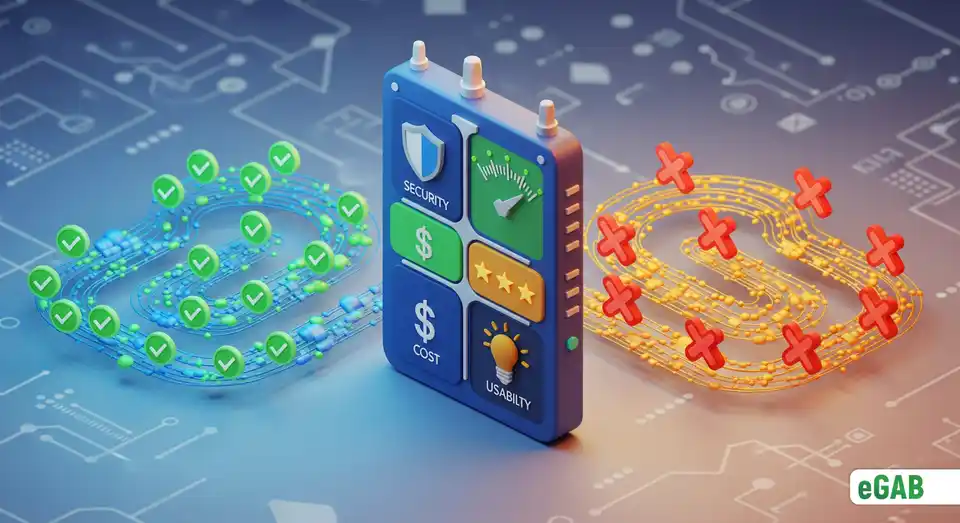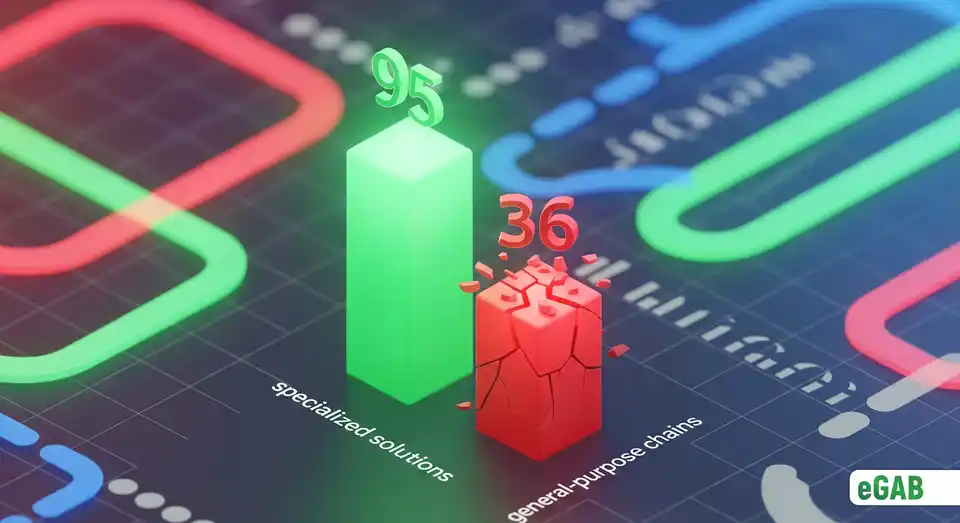Choosing the Right Blockchain for Issuing NFT Credentials: A Comparison Guide

 Author:
Artem Grigoriev
Author:
Artem Grigoriev
- Why Can't You Just Pick Any Popular Blockchain?
- The SESGD Standard: A Yardstick for Comparison
- Comparing Blockchains Across 20 SESGD Criteria
- Results of Blockchain Comparison in Tables
- The Results of the Comparison
- Summary: The Right Tool for a Vital Job - Why a Specialized Blockchain Is the Only Choice
Let's be honest. The moment your institution decides to issue digital diplomas on the blockchain, you run straight into a critical, overwhelming question: Which one do you actually choose?
It’s tempting to think that popularity equals the right fit. You might naturally gravitate towards the big names everyone’s heard of, like Ethereum or Polygon. But here’s the crucial catch. The architecture that works for digital art and finance often falls completely flat, especially when it's applied to digital academic credentials.
Forcing a one-size-fits-all blockchain into education isn't just inefficient-it opens the door to unpredictable costs. It creates serious risks for student data . And frankly, it can become a technical nightmare. This article will break down exactly why you can’t just pick any popular platform. We'll do this by comparing a specialized, turnkey solution against the general-purpose giants, revealing what truly matters for your security, scalability, and long-term legal integrity.
📘 This post is part of our comprehensive guide to "eGAB:The Global Academic Blockchain Ecosystem for Digital Credentials". Explore it to find answers to all your questions ;)
Why Can't You Just Pick Any Popular Blockchain?
Issuing digital diplomas on the blockchain isn't a futuristic fantasy anymore. In fact, these 'NFT documents' are now a real and practical option. The challenge of choosing a blockchain for education isn't just a theoretical debate; it’s a practical hurdle your institution needs to clear. You're almost certainly looking for ways to give your graduates modern, secure, and instantly verifiable credentials. This new world of digital academic credentials promises to completely change how we recognize and validate learning. But as soon as you start digging, a wave of critical, overwhelming questions hits you.
- Which blockchain can you actually trust to keep your students' sensitive data secure?
- How can you afford to issue thousands of digital documents without blowing your budget? This naturally brings up a key question for any administrator: how can universities issue verifiable digital degrees in a way that’s both scalable and sustainable?
- Will these new NFT diplomas really get international recognition? This question gets to the very heart of building a working NFT credentialing system that employers and other schools will actually trust. And how do you navigate all the complex legal red tape?
- Honestly, how big of a technical headache will this be? Does your team even have the ability to implement and maintain a system like this?
The market today is buzzing with options. You've got the big crypto names everyone's heard of, plus newer, more specialized platforms. So how do you cut through all that noise? More importantly, how can you invest in a technology that won't be obsolete in a few years?
At first glance, picking a popular, general-purpose blockchain-a network designed for all sorts of applications, not just one-seems to make perfect sense. Your mind probably jumps to names like Ethereum, Binance Smart Chain, Polygon, or even Bitcoin. After all, they're household names, right? Plus, they have a proven track record in other fields, like finance and digital art. But here’s the critical catch: what works great for trading digital art often falls flat when you apply it to academic credentials. Forcing a one-size-fits-all blockchain on the education sector just creates a new set of major problems. You'll quickly find yourself fighting unpredictable fees, huge energy consumption, complicated setups, and serious legal risks that are tied directly to the volatile world of crypto. Many of these issues are the direct answer to the question of what are the risks of using public blockchains for student data-and these risks are financial, operational, and legal. Without a ready-made " turnkey " ecosystem (a complete, ready-to-use system), you're heading down an inefficient, expensive, and frankly, risky path. This is exactly why finding a true turnkey solution is so critical.
What your institution really needs is a solution that does much more than just let you create NFTs. You need a solution that’s built from the ground up to do it safely, affordably, and conveniently for everyone. And just as importantly, it must align with global educational standards.

The SESGD Standard: A Yardstick for Comparison
So, how do you fairly compare all these different blockchain options? That's exactly why we developed the SESGD Standard . The SESGD standard for blockchains is a specialized filter designed to cut through the marketing hype and focus on what actually matters for education. As we explain in our detailed guide, this framework isn't just about the technology. Instead, it provides a complete, 360-degree assessment of a blockchain's entire ecosystem, judging each one against 20 essential criteria.
Think of the SESGD as a detailed scorecard, meticulously designed for the world of education. It examines everything that truly matters, from the technical nuts and bolts of cryptography (the science of secure communication) and data security to crucial factors like cost-effectiveness, user-friendliness , legal integrity (adhering to laws and ethics), and the long-term sustainability of the solution. One of its smartest features is the principle of reasonable sufficiency . In simple terms, this principle values solutions that are perfectly engineered for educational challenges over those packed with excessive, unneeded tech features. After all, you don't need a Formula 1 engine just to drive to the grocery store, right?
The final assessment score is laid out on a straightforward 100-point scale. This gives you a clear, side-by-side view, helping you make a decision based on data, not just industry hype.
Why It Matters: Let's be real. Choosing a blockchain isn't just a tech decision; it's a strategic one that will have a deep impact on your institution for years to come. Before you commit, use the SESGD framework as your essential checklist. Ask the tough questions. Does this platform genuinely prioritize student data privacy ? This is non-negotiable, as any breach could have devastating results. Is its cost structure predictable and sustainable for your budget? Is it legally compliant across all the regions you serve? Getting these answers upfront will absolutely save you from expensive and stressful headaches down the road.

Comparing Blockchains Across 20 SESGD Criteria
Let's put the SESGD standard into action. We will now compare two fundamentally different paths for issuing educational NFT documents. This brings us to a fundamental question: what is the difference between a specialized and a public blockchain? You can think of it as choosing between a custom-built tool designed for one specific job and a generic multi-tool that's okay at everything but truly great at nothing. This specialized vs general purpose blockchain debate is the central theme of our analysis.
- The Specialized Solution: For this comparison, we will examine the CREST Chain . This is the purpose-built engine that powers the all-in-one eGAB ecosystem, which was designed from the ground up specifically for the education sector. Our eGAB ecosystem review will cover 20 distinct criteria to provide a holistic picture.
- The General-Purpose Solutions: Here, we will analyze popular public blockchains, including big names like Ethereum, BSC, or Polygon. We'll then observe what happens when you attempt to adapt these massive, generalist networks for the highly specific task of issuing academic credentials.
Here is a detailed breakdown that shows how these two approaches stack up.
-
Cryptographic Reliability & Data Protection (Max: 7 points):
- CREST Chain (eGAB): 7/7. It employs advanced security measures, such as dual hashing (a method of encrypting data twice for extra security), and its protocols are specifically engineered to handle the unique nuances of educational data. On top of that, it undergoes regular, rigorous security audits, while its architecture is fundamentally built to shield sensitive student information from potential attacks.
- General-Purpose Chains: 4/7. While the underlying cryptography might be strong, these chains offer no special protection tailored for academic records. The real headache emerges when managing private keys (the secret passwords controlling access to crypto assets) for thousands of users. This process is not only complex and prone to human error, but it can also easily result in lost or stolen NFT diplomas.
-
System Architecture Minimizing Risks (Max: 7 points):
- CREST Chain (eGAB): 6/7. Its architecture is deliberately designed for the educational world. This specialized design minimizes potential weak spots and allows for quick, controlled responses if an issue should ever arise.
- General-Purpose Chains: 5/7. Being public by nature makes their attack surface (the total number of points where an attacker could try to enter) much larger. The security of any application you build on them depends entirely on your developer's code, and data access controls often become a significant point of vulnerability. These applications are built using smart contracts , which, if not coded perfectly, can introduce new security holes.
-
Immutability Guarantee (Max: 7 points):
- CREST Chain (eGAB): 6/7. It provides an ironclad guarantee that once a diploma is recorded on the chain, it can never be altered, thereby ensuring its perpetual integrity. This guarantee of data immutability is a cornerstone of blockchain's value proposition for credentials. Immutability means that data, once written, cannot be changed or deleted.
- General-Purpose Chains: 6/7. While immutability is a core feature of any blockchain, confirming that immutability is an incredibly difficult task for a non-technical person. You would need a user-friendly ecosystem to make it practical, which is a feature they sorely lack.
-
Specialized Architecture for Education (Max: 7 points):
- CREST Chain (eGAB): 7/7. It was built for one single purpose: issuing and managing educational credentials. There are no bloated or redundant features, which makes the system incredibly efficient.
- General-Purpose Chains: 2/7. These systems are simply not optimized for handling academic documents. This fundamental inefficiency leads directly to unnecessary complexity and subpar performance.
-
Energy Efficiency & Eco-Friendliness (Max: 5 points):
- CREST Chain (eGAB): 5/5. It operates on modern, energy-efficient mechanisms that are also environmentally friendly, reflecting a strong and clear commitment to sustainability.
- General-Purpose Chains: 1/5. Many of these public chains are notorious energy hogs, especially those that use a Proof-of-Work (PoW) consensus mechanism (a system where computers solve complex puzzles to validate transactions, consuming vast power). For instance, before its major upgrade, Ethereum's PoW system consumed as much energy as entire countries. While many newer chains have shifted to more efficient methods like proof-of-stake (PoS) , the energy consumption issue on older networks remains a significant concern. For an educational institution, that environmental footprint is a serious reputational problem.
-
Transaction Speed & Predictability (Max: 5 points):
- CREST Chain (eGAB): 5/5. The system is optimized to deliver fast, stable speeds, and this performance holds true whether you are issuing one diploma or verifying a thousand at once.
- General-Purpose Chains: 2/5. The speed on these public networks is often a lottery; it all depends on network congestion (how busy the network is). This means that performance is frequently slow and completely unpredictable.
-
Scalability for Educational Needs (Max: 5 points):
- CREST Chain (eGAB): 5/5. The architecture is built to handle the issuance of credentials on a massive scale (a feature known as scalability ), and it can do so without breaking a sweat.
- General-Purpose Chains: 3/5. To handle scale, they often require complex " Layer-2 " solutions (additional frameworks built on the main blockchain to improve speed and reduce costs). These add-ons are not only expensive but also introduce another layer of technical complexity, which is far from ideal for an educational setting.
-
Cost-Effectiveness & Predictability (Max: 7 points):
- CREST Chain (eGAB): 7/7. Transaction costs are either fixed or nearly zero. This means you can create a predictable and sustainable budget for your operational needs.
- General-Purpose Chains: 1/7. The " gas fees " (transaction costs) on these networks are not only high but also incredibly volatile. The unpredictable nature of gas fees / transaction costs makes budgeting for large-scale issuance nearly impossible. This unfortunate reality makes the mass issuance of credentials a financial nightmare.
-
Availability of a "Turnkey" Ecosystem (Blockchain, Platform, TTP, CA) (Max: 7 points):
- CREST Chain (eGAB): 7/7. This feature is a genuine game-changer. It offers a complete, out-of-the-box solution. The blockchain, the user platform, the Trusted Third Party (TTP) (an impartial organization verifying identities and transactions), and the Certification Authority (CA) (an entity that issues digital certificates) are all integrated and designed to work together seamlessly.
- General-Purpose Chains: 0/7. These are just raw technology. Your institution would have to build or piece together the entire ecosystem itself, which is a massive and costly undertaking.
-
Long-Term Sustainability & Support (Max: 6 points):
- CREST Chain (eGAB): 6/6. There is a clear, transparent development roadmap and a dedicated support plan focused entirely on the educational product.
- General-Purpose Chains: 2/6. The public blockchain itself might survive, but that offers no guarantee that the application you have built on it will receive any meaningful support. You are essentially on your own.
-
Quality of Governance & Specialized Support (Max: 5 points):
- CREST Chain (eGAB): 5/5. You get access to centralized, expert technical support from a team that truly understands the unique challenges of the education sector. Governance here refers to the system of rules and decision-making that guides the network.
- General-Purpose Chains: 0/5. There is no single entity you can call for help. You are left to fend for yourself in sprawling, and often confusing, community forums.
-
Developer Transparency & Focus (Max: 3 points):
- CREST Chain (eGAB): 3/3. The developers are specialists focused solely on education. They operate with full transparency, building features based on real institutional feedback.
- General-Purpose Chains: 2/3. The core developers are focused on a million other things, from finance to gaming. Education is simply not their main priority.
-
Platform Usability & UX (Max: 4 points):
- CREST Chain (eGAB): 3/4. The associated Credly.study platform is designed to be intuitive for everyone-from administrators to students and employers. UX stands for User Experience, which refers to how easy and pleasant the platform is to use. We hold back one point simply because there's always room for improvement!
- General-Purpose Chains: 1/4. Using these systems demands significant technical know-how. Users are forced to navigate complex crypto wallets (software for managing digital assets) and baffling block explorers (tools for viewing raw transaction data on a blockchain).
-
Platform Functionality (Max: 3 points):
- CREST Chain (eGAB): 3/3. It provides all the essential tools you need right out of the box, including customization, mass issuance, and access management features.
- General-Purpose Chains: 1/3. This critical functionality is either missing entirely or requires costly and time-consuming custom development.
-
System Accessibility (Max: 2 points):
- CREST Chain (eGAB): 1/2. The platform is designed with accessibility firmly in mind. However, we hold back a point to reflect our unwavering commitment to future enhancements.
- General-Purpose Chains: 1/2. Accessibility is left to third-party wallets and is therefore not guaranteed.
-
Simplicity and Reliability of Verification (Max: 5 points):
- CREST Chain (eGAB): 5/5. The platform makes verification an absolute breeze. Anyone, anywhere in the world, can do it in just a few simple clicks.
- General-Purpose Chains: 1/5. Verification is a convoluted process that is utterly baffling for non-specialists.
-
Legal & Regulatory Compliance (GDPR, FERPA, etc.) (Max: 5 points):
- CREST Chain (eGAB): 5/5. The entire architecture was meticulously designed from day one with data protection laws like GDPR (Europe's General Data Protection Regulation) and FERPA (the U.S. Family Educational Rights and Privacy Act) in mind. Achieving GDPR / FERPA compliance is therefore a major roadblock for these public platforms.
- General-Purpose Chains: 1/5. This is a huge, often overlooked problem. The unchangeable nature of public blockchains frequently conflicts with data regulations, like GDPR's "right to be forgotten." As legal experts point out, this presents a serious compliance risk. Data written to a public ledger can never be erased, which directly challenges laws like GDPR.
-
Legal Integrity & Independence from Cryptocurrencies (Max: 7 points):
- CREST Chain (eGAB): 7/7. It operates completely independently of any traded cryptocurrencies. This crucial fact removes major legal and financial hurdles, especially in countries with tight crypto regulations.
- General-Purpose Chains: 1/7. Most are inextricably tied to their native cryptocurrencies, creating significant legal and financial exposure for any educational institution that uses them.
-
Support for Interoperability Standards (Max: 1 point):
- CREST Chain (eGAB): 1/1. The ecosystem is fully committed to supporting open interoperability standards (common rules allowing different systems to work together), ensuring the credentials issued are globally compatible and future-proof.
- General-Purpose Chains: 0/1. While tokens can certainly be moved around, that doesn't mean the educational data they represent will be understood by different systems. There is simply no guarantee of meaningful compatibility.
-
Appropriate Degree of Decentralization (Max: 2 points):
- CREST Chain (eGAB): 1/2. This is a deliberate design choice. It utilizes a managed model to ensure accountability, control, and governance-which is exactly what is needed in education, rather than maximum decentralization (where control is spread among many users, not a single entity).
- General-Purpose Chains: 2/2. They are highly decentralized, but this is not always a good thing, particularly when you need clear governance and strict control over sensitive academic data. This entire comparison helps answer the critical question for institutions: are NFT diplomas secure and legally valid when issued on these different types of networks?

Results of Blockchain Comparison in Tables
When you are choosing a technology to protect academic records, technical jargon can be a major hurdle. How can you focus on what truly matters? The key is to use a clear, objective comparison. We have used the SESGD standard to see how a specialized tool like CREST Chain stacks up. This framework, built to evaluate blockchains for educational use, was used to compare it directly against general-purpose chains such as Ethereum, BSC, or Polygon. A key part of this evaluation is support for modern data standards, including Verifiable Credentials (VCs) and Decentralized Identifiers (DIDs) , which ensure credentials are both trustworthy and interoperable.
The results are not just slightly different; they are a definite wake-up call. The numbers clearly demonstrate why a purpose-built system is the only sensible option for this incredibly critical task.
Let's begin by looking at the big picture. Here is a side-by-side performance comparison based on the 20 SESGD criteria.
| Category | CREST Chain (eGAB) | General-Purpose Chains | | :--- | :---: | :---: | | 1. Cryptographic Reliability | 7 | 4 | | 2. System Architecture | 6 | 5 | | 3. Immutability Guarantee | 6 | 6 | | 4. Specialized Architecture | 7 | 2 | | 5. Energy Efficiency | 5 | 1 | | 6. Transaction Speed | 5 | 2 | | 7. Scalability | 5 | 3 | | 8. Economic Efficiency | 7 | 1 | | 9. "Turnkey" Ecosystem | 7 | 0 | | 10. Long-Term Sustainability | 6 | 2 | | 11. Quality of Governance | 5 | 0 | | 12. Developer Transparency | 3 | 2 | | 13. Platform Usability | 3 | 1 | | 14. Platform Functionality | 3 | 1 | | 15. System Accessibility | 1 | 1 | | 16. Simplicity of Verification| 5 | 1 | | 17. Legal Compliance | 5 | 1 | | 18. Legal Integrity | 7 | 1 | | 19. Standards Support | 1 | 0 | | 20. Degree of Decentralization| 1 | 2 | | Total | 95/100 | 36/100 |
As you can clearly see, the difference is like night and day. CREST Chain earns an exceptional 95 out of 100, showcasing a solution that is almost perfectly engineered for handling educational credentials. In stark contrast, general-purpose chains barely scrape by with just 36 out of 100 . Why is there such a huge gap? It all comes down to the key areas where a specialized tool truly shines:
- Cost and Efficiency (The Price of Admission): This is a complete deal-breaker. General-purpose chains score a dismal 1/7 on cost because of their wild and unpredictable " gas fees ," making credential issuance at scale a financial gamble. In contrast, CREST Chain, which was built for this exact task, features predictable, negligible costs and is dramatically more energy-efficient.
- The "Turnkey" Ecosystem (Everything in the Box): This may just be the most important difference. CREST Chain achieves a perfect 7/7 because it is part of the eGAB ecosystem-a complete, ready-to-use solution. This includes the platform, a Trusted Third Party (TTP) , and a Certification Authority (CA) . General-purpose chains score a zero because they are just raw tech; you would have to build the entire trust framework completely from scratch.
- Legal and Governance (Playing by the Rules): CREST Chain earns perfect scores for legal integrity and top marks for governance because it is built to comply with global regulations like GDPR and operates independently of volatile cryptocurrencies. Public chains, on the other hand, pose huge legal risks for any serious educational institution. Their "wild west" nature and dependency on crypto are a major liability.
For those who enjoy looking under the hood, here is a more technical comparison that shows how CREST Chain stacks up against other well-known blockchain technologies.
| Feature | CREST Chain | Hyperledger Indy on Besu | Hyperledger Indy | Ethereum-Based Public Chains | Hyperledger Fabric (Private) | | :--- | :--- | :--- | :--- | :--- | :--- | | Permission Model | Permissioned centralized (TTP-governed) (A central authority grants access) | Public-hybrid permissioned (Mix of public access and restricted control) | Consortium permissioned (Controlled by a group of organizations) | Permissionless, public (Open to anyone) | Permissioned, private (Access is restricted to specific users) | | Consensus (How the network agrees on truth) | TTP-anchored dual hashing (A central party validates encrypted data) | IBFT 2.0 or PoA (Proof-of-Authority, where approved accounts validate) | RBFT (A fault-tolerant group validation method) | Proof-of-Stake (PoS) (Validators lock up crypto to secure the network) | PBFT/YAC (Methods for fast consensus in private groups) | | SESGD Score | 95 | n/a | n/a | ~36 (ETH, BSC, Polygon) | n/a | | DID & VC Support (Support for digital identity standards) | Native W3C VC/DID, TTP–verified (Built-in support for official web standards for Verifiable Credentials and Decentralized IDs) | Native DIDs & VCs (Built-in support for digital IDs) | Native DIDs & VCs (Built-in support for digital IDs) | Indirect (Blockcerts, CACAO) (Requires third-party tools) | Via Aries plugin (Requires an add-on) | | Interoperability (Ability to work with other systems) | Seamless integration with Credly.study | High (Ethereum tools + Indy) | Limited SSI ecosystem | Extensive Ethereum ecosystem | Moderate Hyperledger ecosystem | | Throughput & Latency (Network speed and delay) | Instant verification; near-zero fees | ~100 TPS (Transactions Per Second), ~0.1 s consensus | ~5–10 TPS, ~1 s registration | ~30 TPS; ~3 s registration | ~1,000 TPS; ~0.5 s consensus | | Cost-Efficiency | Negligible fees; energy-efficient | Low | Low | Variable gas costs | Fixed operational costs | | Governance (How rules are made and enforced) | Centralized TTP ensures global legal adherence | Consortium + public standards | Consortium governance | Decentralized; variable jurisdiction | Enterprise governance | | Key Use Cases | Diplomas, certificates, awards | eIDAS2.0-compliant national wallets (European digital ID wallets) | Self-sovereign portfolios (User-controlled identity systems) | Public diplomas anchors (Public proof of a credential's existence) | Private inter-university consortia (Collaborations between select universities) |
This deep dive reveals that while other technologies certainly have their strengths and may be great for private networks or self-sovereign identity (a model where individuals control their digital identity), CREST Chain is uniquely optimized. This concept of self-sovereign identity (SSI) is indeed powerful, but it needs a practical and secure framework to be truly effective for official credentials. It is designed for one critical mission: issuing official academic credentials with instant verification, incredible cost-efficiency, and built-in legal governance.
Why It Matters: The key takeaway from all this is simple. Choosing a blockchain is not about picking the most famous brand name; it is about selecting the right tool for the right job. The data makes it crystal clear: for issuing secure, affordable, and globally compliant academic credentials, a specialized ecosystem like eGAB is not just another option-it is the only one that truly makes the grade.

The Results of the Comparison
So, what is the final verdict? After running both options through the rigorous 20-point SESGD analysis, the results are abundantly clear. They are not just slightly different; they reveal a massive gap in fitness for the educational world. This begs the question that many treasurers are asking: how much does it cost to put diplomas on the blockchain? Our analysis shows that with the right solution, it can be surprisingly affordable.
Let's start with the specialized solution. CREST Chain, as part of the eGAB ecosystem, earns a stellar 95 out of 100. This is not just a high number; it is definitive proof of a system that is almost perfectly fine-tuned for managing academic credentials. It excels in the areas that truly matter to an institution like yours:
- Rock-solid security and data protection, thanks to an architecture designed from the ground up specifically to safeguard academic records. The end goal is to provide graduates with secure digital diplomas that are resistant to fraud and easy to verify.
- Astounding cost-effectiveness, offering predictable, near-zero transaction fees that make issuing diplomas at scale financially viable. This directly addresses a primary concern for any institution: the cost of issuing NFT credentials (as further explored in our article).
- A complete "turnkey" ecosystem, which includes a user-friendly platform and integrated trust services (TTP and CA), saving you the immense headache and cost of building it all yourself. This is the incredible value of a true turnkey solution . Essentially, it provides a complete verifiable credentials platform right out of the box.
- Guaranteed legal compliance and integrity, freeing you from the regulatory minefield associated with public cryptocurrencies.
- Dependable, long-term support from a dedicated team focused solely on the unique needs of the education sector.
Now, let's turn our attention to general-purpose blockchain solutions . Their average score is a jaw-dropping ~36 out of 100. This failing grade tells a very clear story: while these technologies may be powerful for finance or collectibles, they are absolutely the wrong tool for this job. They fail on several critical, deal-breaking points:
- High and wildly unpredictable transaction costs, commonly known as " gas fees ."
- Serious compliance conflicts with essential data privacy laws like GDPR .
- A direct, and therefore risky, dependence on the volatile cryptocurrency market.
- A lack of a ready-made, easy-to-use ecosystem for your staff, students, and employers.
- No dedicated support team available to help you navigate the unique challenges of the education sector.
The numbers truly speak for themselves. Issuing educational NFT documents is a critical and highly specific mission. For this important job, a purpose-built solution does not just perform better-it's in a different league entirely.
Конечно, вот первый вариант, дополненный самыми сильными и конкретизирующими предложениями из второго варианта. Все оригинальные предложения из первого текста сохранены в нетронутом виде.

Summary: The Right Tool for a Vital Job - Why a Specialized Blockchain Is the Only Choice
Choosing the right blockchain for your NFT documents is a huge decision. The blockchain for NFT credentials you adopt will have lasting consequences. It's a strategic investment in your institution's reputation, your operational efficiency, and, most importantly, your graduates' futures. By using a tamper-proof ledger, this technology finally answers the question: how does blockchain prevent academic fraud? As our deep-dive comparison clearly shows, not all blockchains are created equal -especially when you're dealing with the unique pressures and responsibilities of the academic world. The stakes get even higher when you learn the shocking truth about academic fraud: it's a global industry worth over $21 Billion USD , a figure Dr. Sarah Eaton shared in an interview on The EvoLLLution (Understanding Fake Degrees and Credential Fraud in Higher Ed).
It's tempting to go with popular, general-purpose blockchains. But as we've shown, they come with serious baggage. You're looking at sky-high costs, legal minefields, and a level of complexity that creates more work, not less. Specifically, you'll face the wildly unpredictable cost of issuing NFT credentials thanks to volatile "gas fees," run into major legal headaches around GDPR/FERPA compliance, and accept the risks that come with being tied to the cryptocurrency market. Trying to force these systems to fit the world of education is like performing delicate surgery with a sledgehammer-it’s just the wrong tool for the job. This mess leaves many wondering, how do you create an NFT diploma without getting stuck in a technical swamp? The answer is choosing an all-in-one ecosystem that handles all that complexity for you.
This is exactly why specialized solutions like CREST Chain were designed. Operating within the complete eGAB ecosystem, it was engineered from the ground up to be the perfect tool for this vital job. It wasn't just adapted for education; we meticulously engineered it from day one to solve your biggest institutional headaches right out of the box. We built it to issue NFT diplomas and blockchain for university certificates in a way that’s secure, compliant, and simple to manage. We built it with the real-world needs of your institution, your students, and their future employers always in mind, delivering:
- Security and reliability you can trust with sensitive personal data.
- Cost-effectiveness that makes modernizing your credentials financially sustainable.
- A complete "turnkey" ecosystem with a simple platform and built-in trust services.
- Full legal compliance and integrity you can stand behind with confidence.
- Effortless simplicity that empowers everyone, from your administrators to your graduates.
The final score says it all. CREST Chain (eGAB) earned an impressive 95 points on the SESGD standard , while general-purpose solutions managed to score only ~36 points . This huge gap isn't about minor features; it's abo
ut a fundamental difference in design philosophy. This fact proves the point beyond any reasonable doubt.
So, to answer the question, "Which blockchain is better?"-the answer is clear. Ultimately, when deciding which blockchain is best for issuing educational credentials, the evidence points overwhelmingly to a specialized system. For educational NFT documents , the best choice is a thoughtful, specialized ecosystem built to solve the real challenges of education. It’s an investment in your security, your prestige, and the lifelong success of your graduates. For the critical mission of issuing educational NFT documents , a purpose-built, specialized ecosystem isn't just the best option-it's the only one that truly makes the grade.
Your Next Step: Are you ready to see how a specialized ecosystem can completely transform your credential management? You can dive deeper into the core principles of verifiable data by exploring the official W3C Recommendation for the Verifiable Credentials Data Model (Verifiable Credentials Data Model v2.0) . The W3C (World Wide Web Consortium) is the main international standards organization for the World Wide Web. This recommendation acts as the foundational standard for creating trustworthy digital credentials that work everywhere. Following these W3C standards ensures that the credentials you issue will be recognized and understood globally, future-proofing them against technological changes.
➡️ Where do we go from here? Now that we've compared the underlying tech, let's look at where the leading platform is headed. Discover the future of digital academic credentials on the eGAB blockchain.

The Tangible Benefits of eGAB for Universities, Students, and Employers
How eGAB Fulfills the Vision of the Global Digital Credentials Management Program
Blockchain, NFT, TTP & CA for Academic Credentials: A Simplest Explanation
Why Blockchain and NFTs Are Essential for Credential Verification
The Future of Digital Credentials (Powered by eGAB)
